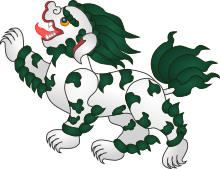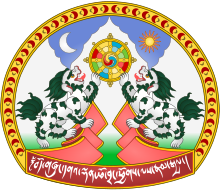Snow Lion

The Snow Lion (sometimes spelled snowlion;
As national emblem of Tibet

From 1909 until 1959, a single snow lion or a pair of them was used as the national
In Tibetan culture

Snow lion is frequently mentioned in Tibetan folk songs and proverbs. It is thought to live in the highest mountains as it is the "king of beasts" that would tower over other animals of the lower levels. Snow lions may also represent hermits and yogis who live high up in the mountains.[1] Marpa was called to interpret the meaning when, "Tibet's great yogin, Milarepa, once had a prophetic dream which included a snow lion."[7]
Snow Lioness milk
In Tibetan lore, two Tibetan culture heroes, Gesar and Milarepa, were said to have been raised by snow lioness.[1] The milk of the Snow Lioness (Tibetan: Gangs Sengemo) is reputed to contain special nutrients to heal the body and restore it to harmony. Some holy medicinal remedies are believed to contain the essence of Snow Lioness milk. Her milk is also used to symbolise the Dharma and its purity, as Milarepa replies to a man seeking to buy the Dharma from him with expensive gifts:
"I, the snow lioness who stays in snowy solitudes, Have milk which is like the essential nectar. In the absence of golden cups, I would not pour it in an ordinary vessel."
Legend has it that the lioness produces milk from its paws, and the milk may pass into hollow balls given to the lioness to play with. This ball may be represented in Tibetan art as a three-coloured "wheel of joy" (dga' 'khyil).[8]
Snow Lion dance
A form of lion dance found in the Tibetan areas is called the snow lion dance or Senggeh Garcham.[9] The name seng ge and its related forms come from Sanskrit siṅha,[1] and cham or garcham is a Buddhist ritual dance.[10] The snow lion dance may be performed as a secular dance, or as a ritual dance performed by bon po monks.[1] This dance may also be found among people in other Himalayan regions such as the Monpa people in Arunachal Pradesh,[11] and in Sikkim where it is called Singhi Chham.[12]
In Buddhist art

The lion was adopted as a symbol of
The body of the Snow Lion is white while its flowing hair of mane, tail and curls on legs, is either blue or green. While most Snow Lions are gender neutral in Buddhist art there are some that are represented as obviously male and some as obviously female. When represented as a symmetrical pair the male is on the left and the female on the right. Sculptural Snow Lions are often in repousse metal that has been gilt and painted.
Attributes


The Snow Lion is a
.Roar
The roar of the Snow Lion embodies the sound of 'emptiness' (Sanskrit:
Tibetan Lion Dog
The Shih Tzu,[13] Lhasa Apso and Tibetan Terrier are also called the Lion Dog which may be due to their resemblance to the Snow Lion.[7] However it is unknown whether the dogs were bred to resemble the Snow Lion or if the artistic depiction of the Snow Lion was influenced by the features of the dogs.
See also
References
- ^ ISBN 9004125965
- ^ "Legend of the SnowLion". Snow Lion Tour.
- ^ "Tibetan Buddhist Symbols". A view on Buddhism.
- ^ a b Rudy Harderwijk. "The Four Dignities". Symbols of Tibetan Buddhism. A View on Buddhism. Archived from the original on October 13, 2004. Retrieved 19 January 2007.
- ^ 呉承恩 (25 October 2014). 西遊記: Journey to the West. Google Publishing. pp. 524–. GGKEY:641CHU5H2P8.
- ISBN 9781498503341.
- ^ ISBN 9780906026489.
- ^ ISBN 978-1932476033.
- ^ "Tibetan Snow Lion Dance". Tibet Views. Archived from the original on 4 March 2016.
{{cite web}}: CS1 maint: unfit URL (link) - ^ "Garcham". itibetan.org.
- ^ "Tawang Festival". India Travel. Archived from the original on 25 January 2013.
- ISBN 978-8124108666.
- ISBN 9780876053362.
